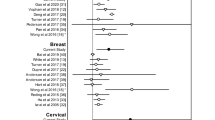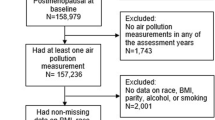Abstract
Short-term effects of ambient particulate matter (PM) on cardiopulmonary morbidity and mortality have been consistently documented. However, no study has investigated its long-term effects on breast cancer survival. We selected all female breast cancer cases (n = 255,128) available in the California Surveillance Epidemiology and End Results cancer data. These cases were linked to 1999–2009 California county-level PM daily monitoring data. We examined the effect of PM on breast cancer survival. Results from Kaplan–Meier survival analysis show that female breast cancer cases living in areas with higher levels of PM10 and PM2.5 had a significant shorter survival than those living in areas with lower exposures (p < 0.0001). The results from marginal cox proportional hazards models suggest that exposure to higher PM10 (HR 1.13, 95 % CI 1.02–1.25, per 10 μg/m3) or PM2.5 (HR 1.86, 95 % CI 1.12–3.10, per 5 μg/m3) was significantly associated with early mortality among female breast cancer cases after adjusting for individual-level covariates such as demographic factors, cancer stage and year diagnosed, and county-level covariates such as socioeconomic status and accessibility to medical resources. Interactions between cancer stage and PM were also observed; the effect of PM on survival was more pronounced among individuals diagnosed with early stage cancers. This study suggests that exposure to high levels of PM may have deleterious effects on the length of survival from breast cancer, particularly among women diagnosed with early stage cancers. The findings from this study warrant further investigation.

Similar content being viewed by others
Abbreviations
- CI:
-
Confidence interval
- EPA:
-
U.S. environmental protection agency
- HR:
-
Hazard ratio
- ICD-O-3:
-
International classification of disease for oncology, third edition
- PM:
-
Particulate matter
- PM10 :
-
Particles less than 10 μm in diameter
- PM2.5 :
-
Particles less than 2.5 μm in diameter
- SEER:
-
Surveillance Epidemiology and End Results
References
Society AC (2012) Cancer facts and figures 2012. American Cancer Society, Atlanta
Carey LA, Perou CM, Livasy CA, Dressler LG, Cowan D, Conway K, Karaca G, Troester MA, Tse CK, Edmiston S et al (2006) Race, breast cancer subtypes, and survival in the Carolina breast cancer study. JAMA J Am Med Assoc 295(21):2492–2502
Braithwaite D, Izano M, Moore DH, Kwan ML, Tammemagi MC, Hiatt RA, Kerlikowske K, Kroenke CH, Sweeney C, Habel L et al (2012) Smoking and survival after breast cancer diagnosis: a prospective observational study and systematic review. Breast Cancer Res Treat 136(2):521–533
Grant WB (2009) Air pollution in relation to U.S. cancer mortality rates: an ecological study; likely role of carbonaceous aerosols and polycyclic aromatic hydrocarbons. Anticancer Res 29(9):3537–3545
Chameides WL (2010) Environmental factors in cancer: focus on air pollution. Rev Environ Health 25(1):17–22
Eitan O, Yuval, Barchana M, Dubnov J, Linn S, Carmel Y, Broday DM (2010) Spatial analysis of air pollution and cancer incidence rates in Haifa Bay, Israel. Sci Total Environ 408(20):4429–4439
Raaschou-Nielsen O, Andersen ZJ, Hvidberg M, Jensen SS, Ketzel M, Sorensen M, Hansen J, Loft S, Overvad K, Tjonneland A (2011) Air pollution from traffic and cancer incidence: a Danish cohort study. Environ Health 10:67
Chen F, Bina WF (2012) Correlation of white female breast cancer incidence trends with nitrogen dioxide emission levels and motor vehicle density patterns. Breast Cancer Res Treat 132(1):327–333
Wei Y, Davis J, Bina WF (2012) Ambient air pollution is associated with the increased incidence of breast cancer in US. Int J Environ Health Res 22(1):12–21
TRI National Analysis (2011) http://www.epa.gov/tri/tridata/tri11/nationalanalysis/index.htm
Boffetta P, Nyberg F (2003) Contribution of environmental factors to cancer risk. Br Med Bull 68:71–94
van Berlo D, Hullmann M, Schins RP (2012) Toxicology of ambient particulate matter. EXS 101:165–217
Yanagi Y, Assuncao JV, Barrozo LV (2012) The impact of atmospheric particulate matter on cancer incidence and mortality in the city of Sao Paulo, Brazil. Cad de Saude Publica/Ministerio da Saude, Fundacao Oswaldo Cruz, Escola Nacional de Saude Publica 28(9):1737–1748
Anderson JO, Thundiyil JG, Stolbach A (2012) Clearing the air: a review of the effects of particulate matter air pollution on human health. J Med Toxicol 8(2):166–175
Lee EWL, Amato D (1992) Cox-type regression analysis for large numbers of small groups of correlated failure time observations. Kluwer Academic Publishers, Dordrecht
Lin DY (1994) Cox regression analysis of multivariate failure time data: the marginal approach. Stat Med 13(21):2233–2247
Zeger SL, Dominici F, McDermott A, Samet JM (2008) Mortality in the Medicare population and chronic exposure to fine particulate air pollution in urban centers (2000–2005). Environ Health Perspect 116(12):1614–1619
Sarnat JA, Schwartz J, Suh HH (2001) Fine particulate air pollution and mortality in 20 U.S. cities. N Engl J Med 344(16):1253–1254
Puett RC, Hart JE, Suh H, Mittleman M, Laden F (2011) Particulate matter exposures, mortality, and cardiovascular disease in the health professionals follow-up study. Environ Health Perspect 119(8):1130–1135
Pope CA 3rd, Burnett RT, Thun MJ, Calle EE, Krewski D, Ito K, Thurston GD (2002) Lung cancer, cardiopulmonary mortality, and long-term exposure to fine particulate air pollution. JAMA J Am Med Assoc 287(9):1132–1141
Levy JI, Hammitt JK, Spengler JD (2000) Estimating the mortality impacts of particulate matter: what can be learned from between-study variability? Environ Health Perspect 108(2):109–117
Hung L-J, Tsai S-S, Chen P-S, Yang Y-H, Liou S-H, Wu T-N, Yang C-Y (2012) Traffic air pollution and risk of death from breast cancer in Taiwan: fine particulate matter (PM2.5) as a proxy marker. Aerosol Air Qual Res 12:275–282
Lodovici M, Bigagli E (2011) Oxidative stress and air pollution exposure. J Toxicol 2011:487074
Pope CA 3rd (2000) Epidemiology of fine particulate air pollution and human health: biologic mechanisms and who’s at risk? Environ Health Perspect 108(Suppl 4):713–723
KA Dobson, JL Freudenheim, PG Shields, MH Tao, C Marian, J Nie, SB Edge, JS Winston, M Trevisan, MR Bonner (2011) Air pollution exposure and promoter methylation of E-cadherin, p16, and RAR-β in breast cancer tumors from cases in the WEB study. In: Proceedings of the 102nd annual meeting of the American association for cancer research. Cancer Research, Orlando, 2–6 April 2011
Moore CJ, Tricomi WA, Gould MN (1986) Interspecies comparison of polycyclic aromatic hydrocarbon metabolism in human and rat mammary epithelial cells. Cancer Res 46(10):4946–4952
Mane SS, Purnell DM, Hsu IC (1990) Genotoxic effects of five polycyclic aromatic hydrocarbons in human and rat mammary epithelial cells. Environ Mol Mutagen 15(2):78–82
Gammon MD, Santella RM, Neugut AI, Eng SM, Teitelbaum SL, Paykin A, Levin B, Terry MB, Young TL, Wang LW et al (2002) Environmental toxins and breast cancer on Long Island. I. Polycyclic aromatic hydrocarbon DNA adducts. Cancer Epidemiol Biomark Prev 11(8):677–685
Gammon MD, Sagiv SK, Eng SM, Shantakumar S, Gaudet MM, Teitelbaum SL, Britton JA, Terry MB, Wang LW, Wang Q et al (2004) Polycyclic aromatic hydrocarbon–DNA adducts and breast cancer: a pooled analysis. Arch Environ Health 59(12):640–649
Li D, Wang M, Dhingra K, Hittelman WN (1996) Aromatic DNA adducts in adjacent tissues of breast cancer patients: clues to breast cancer etiology. Cancer Res 56(2):287–293
Rundle A, Tang D, Hibshoosh H, Estabrook A, Schnabel F, Cao W, Grumet S, Perera FP (2000) The relationship between genetic damage from polycyclic aromatic hydrocarbons in breast tissue and breast cancer. Carcinogenesis 21(7):1281–1289
Chen ST, Lin CC, Liu YS, Lin C, Hung PT, Jao CW, Lin PH (2013) Airborne particulate collected from central Taiwan induces DNA strand breaks, poly (ADP-ribose) polymerase-1 activation, and estrogen-disrupting activity in human breast carcinoma cell lines. J Environ Sci Health Part A Toxic/Hazard Subst Environ Eng 48(2):173–181
Health USDoHaHSOoWs (2010) Early-stage breast cancer treatment fact sheet. U.S. Department of Health and Human Services, Washington, DC
Sagiv SK, Gaudet MM, Eng SM, Abrahamson PE, Shantakumar S, Teitelbaum SL, Bell P, Thomas JA, Neugut AI, Santella RM et al (2009) Polycyclic aromatic hydrocarbon-DNA adducts and survival among women with breast cancer. Environ Res 109(3):287–291
Petro-Nustas W (2002) Health-related behaviors and lifestyle factors of patients with breast cancer. Cancer Nurs 25(3):219–229
Pinto BM, Trunzo JJ (2005) Health behaviors during and after a cancer diagnosis. Cancer 104(11 Suppl):2614–2623
Disclosure
There are no financial disclosures to report.
Author information
Authors and Affiliations
Corresponding author
Rights and permissions
About this article
Cite this article
Hu, H., Dailey, A.B., Kan, H. et al. The effect of atmospheric particulate matter on survival of breast cancer among US females. Breast Cancer Res Treat 139, 217–226 (2013). https://doi.org/10.1007/s10549-013-2527-9
Received:
Accepted:
Published:
Issue Date:
DOI: https://doi.org/10.1007/s10549-013-2527-9




